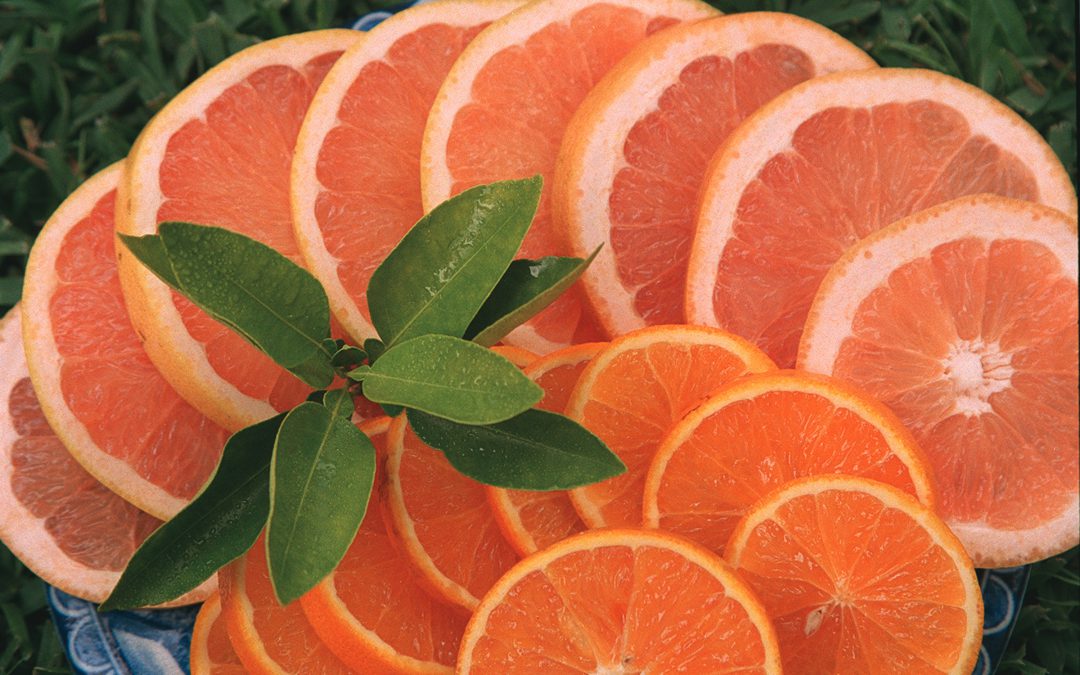
by Ray Bodrey | Apr 8, 2021
The Sunshine State produces a wide selection of citrus, with a number of varieties that can be grown right here, in your Panhandle dooryard. And, what is more satisfying than picking fresh fruit from your very own trees? So, are you looking for a different variety to plant? The ‘Parson Brown’ sweet orange may be of interest. It can certainly add uniqueness to your dooryard citrus grove.
Originating in China, orange varieties began being introduced in Europe in the fifteenth century. As for introduction to America, Columbus brought orange seeds to the new world on his second voyage in 1493. The first plantings in Florida were around 1513 in the settlement of St. Augustine. For the ‘Parson Brown’, a chance seedling originated at the home of Reverend N.L. Brown near Webster in 1856. Sumter and Seminole counties are still home to some of the largest densities of ‘Parson Brown’ orange trees in the state.
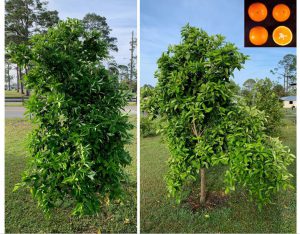
Figure 1: ‘Parson Brown’ Sweet Orange. Credit: D.P.H. Tucker, Ray Bodrey, UF/IFAS.
The Parson Brown, however, is often overlooked. The most popular dooryard sweet orange varieties grown throughout Florida are Navel, Hamlin, Valencia and Pineapple. Availability of this variety in our region is not easily found either, as you may have to search to find a tree.
Unlike the short, round appearance of many citrus trees, the Parson Brown tends to grow tall and slim. The Parson Brown’s more upright tree structure is very distinctive. A specimen will certainly stand out in a grove. The fruit and yield rival a Hamlin orange, particularly when grown in heavy, hammock soils rather than sandy soils with low organic content. The variety is also not as marketable as the Hamlin on a commercial level, due to the heavier seediness. You can expect at least 10 seeds per fruit. Average diameter of fruit is between 2 ½” to 2 ¾”. Harvest season for fruit is generally between October and January. Evidence suggests that along with the ‘Sugar Belle’ variety, the ‘Parson Brown’ may be more disease resistant, specifically more tolerant to citrus greening. HLB or citrus greening is a disease that has devastated both commercial production and dooryard citrus across the state.
Contact your local county extension office for more information. Also, for more information on growing citrus in Florida, see the UF/IFAS Extension EDIS publication, “Citrus Culture in the Home Landscape” by Robert E. Rouse and Mongi Zekri.
UF/IFAS Extension is an Equal Opportunity Institution.
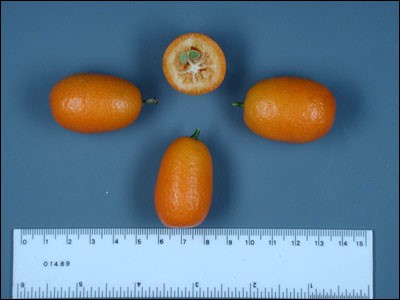
by Mary Salinas | May 5, 2016
The panhandle of Florida is a great place to grow citrus with our plentiful sunshine and sandy soil. But some varieties do better than others. Here are some that thrive in the more northerly climes of Florida:
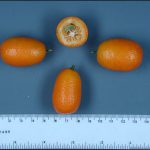
Nagami kumquat. Photo credit: UF/IFAS.
- Satsuma mandarin is cold hardy to 15°F once established. There are a few different available cultivars with fruit ripening October through December. Fruit needs to be picked promptly when ripe.
- Kumquat is cold hardy to 10°F once established. ‘Nagami’ and ‘Meiwa’ are the two common cultivars of the small tart fruits. Fruit matures in fall and winter and holds fairly well on the trees.
- Calamondin is a lesser known variety that bears small fruit that resemble tangerines. The tart fruit is great for jams and chutneys. Fruit is borne all year.
- Some of the sweet oranges that do well in the panhandle are Navel, Hamlin and Parson Brown. They are cold hardy to 14°F once established and are harvested November through January.
- Minneola or Honeybell tangelo is also hardy to 14°F and harvested in January. This is a cross between a Duncan grapefruit and a Darcy tangerine. This bell-shaped fruit is very juicy and sweet. Unlike the other citrus varieties, it needs another citrus nearby for cross-pollination in order to produce an abundant crop.
- Meyer Lemon is the choice to make if you would like to grow lemons in the panhandle. Other lemons may be damaged by our occasional freezes.
Grapefruit and lime can be grown – although unreliably – on the coast with protection from northwestern winter winds. They are much more susceptible to freezes in more northerly panhandle locations.
In order to have the healthiest and most productive trees, learn about how to properly care for citrus and how to recognize and combat the pests and diseases that occur.
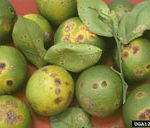
Citrus canker symptoms on leaves, fruit and stem. Photo by Timothy Schubert, FDACS
There are threats to our dooryard and commercial citrus from pests and disease. Only vigilance will help to combat the challenges so that we may continue to grow and enjoy our citrus. What can we do to protect our citrus?
- Report any serious diseases like suspected citrus canker or citrus greening to the Division of Plant Industry by calling toll-free 1-888-397-1517. Inspections and diagnosis are free. Citrus canker has been confirmed in south Santa Rosa County in the past 3 years.
- Purchase citrus trees only from registered nurseries – they may cost a little more but they have gone through an extensive process to remain disease and pest free. That will save you $$ in the long run!
- Don’t bring plants or fruit back into Florida – they may be harboring a pest!
- Citrus trees or fruit cannot move in or out of the State of Florida without a permit. This applies to homeowners as well as to the industry. This rule protects our vital dooryard trees and citrus industry.
For more information please see:
Save Our Citrus Website
UF IFAS Gardening Solutions: Citrus
Citrus Culture in the Home Landscape
UF IFAS Extension Online Guide to Citrus Diseases
Your Florida Dooryard Citrus Guide – Common Pests, Disease and Disorders of Dooryard Citrus





